Involvement of cAMP-dependent protein kinase in the nucleus accumbens in cocaine self-administration and relapse of cocaine-seeking behavior
- PMID: 9465009
- PMCID: PMC6792608
- DOI: 10.1523/JNEUROSCI.18-05-01848.1998
Involvement of cAMP-dependent protein kinase in the nucleus accumbens in cocaine self-administration and relapse of cocaine-seeking behavior
Abstract
cAMP-dependent protein kinase (PKA) in the nucleus accumbens (NAc) has been implicated in cocaine addiction because (1) cocaine reinforcement is mediated by dopamine receptors that modulate cAMP formation, and (2) repeated exposure to cocaine upregulates the cAMP system in NAc neurons. This study tested PKA involvement in cocaine self-administration and relapse of cocaine-seeking behavior by infusing cAMP analogs that activate or inhibit PKA into the NAc of rats. Bilateral intra-NAc infusions of the PKA inhibitor Rp-cAMPS reduced baseline cocaine self-administration, shifted the dose-response curve for cocaine self-administration to the left, and induced relapse of cocaine-seeking behavior after extinction from cocaine self-administration, consistent with an enhancement of cocaine effects in each paradigm. In contrast, pretreatment with intra-NAc infusions of a PKA activator, Sp-cAMPS or dibutyryl cAMP, increased baseline cocaine self-administration during the second hour of testing and shifted the dose-response curve to the right, consistent with an antagonist-like action. After extinction from cocaine self-administration, similar infusions of Sp-cAMPS induced generalized responding at both drug-paired and inactive levers. As an index of PKA activity in vivo, NAc infusions of Rp-cAMPS reduced basal levels of dopamine-regulated phosphoprotein-32 phosphorylation and blocked amphetamine-induced increases in cAMP response element-binding protein (CREB) phosphorylation. Conversely, NAc infusions of Sp-cAMPS increased phosphorylation of CREB. Together, these results suggest that sustained upregulation of the cAMP system in the NAc after repeated cocaine exposure could underlie tolerance to cocaine reinforcement, whereas acute inhibition of this system may contribute to drug craving and relapse in addicted subjects.
Figures
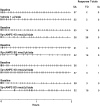
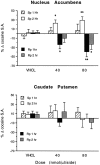



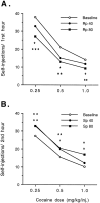
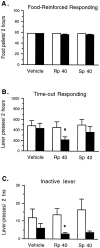

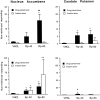



Similar articles
-
Relapse to cocaine-seeking after abstinence is regulated by cAMP-dependent protein kinase A in the prefrontal cortex.Addict Biol. 2014 Jan;19(1):77-86. doi: 10.1111/adb.12043. Epub 2013 Mar 6. Addict Biol. 2014. PMID: 23461423 Free PMC article.
-
Antisense-induced reduction in nucleus accumbens cyclic AMP response element binding protein attenuates cocaine reinforcement.Neuroscience. 2006;137(2):373-83. doi: 10.1016/j.neuroscience.2005.10.049. Epub 2005 Dec 15. Neuroscience. 2006. PMID: 16359811
-
The decreased cyclic-AMP dependent-protein kinase A function in the nucleus accumbens: a role in alcohol drinking but not in anxiety-like behaviors in rats.Neuropsychopharmacology. 2006 Jul;31(7):1406-19. doi: 10.1038/sj.npp.1300900. Epub 2005 Sep 28. Neuropsychopharmacology. 2006. PMID: 16192983
-
Reflections on: "A general role for adaptations in G-Proteins and the cyclic AMP system in mediating the chronic actions of morphine and cocaine on neuronal function".Brain Res. 2016 Aug 15;1645:71-4. doi: 10.1016/j.brainres.2015.12.039. Epub 2015 Dec 29. Brain Res. 2016. PMID: 26740398 Free PMC article. Review.
-
The role of accumbal hypoactivity in cocaine addiction.ScientificWorldJournal. 2007 Nov 2;7:22-45. doi: 10.1100/tsw.2007.266. ScientificWorldJournal. 2007. PMID: 17982574 Free PMC article. Review.
Cited by
-
Effects of intra-nucleus accumbens shell administration of dopamine agonists and antagonists on cocaine-taking and cocaine-seeking behaviors in the rat.Psychopharmacology (Berl). 2005 Nov;183(1):41-53. doi: 10.1007/s00213-005-0133-1. Epub 2005 Oct 22. Psychopharmacology (Berl). 2005. PMID: 16163523
-
Long-lasting potentiation of GABAergic synapses in dopamine neurons after a single in vivo ethanol exposure.J Neurosci. 2002 Mar 15;22(6):2074-82. doi: 10.1523/JNEUROSCI.22-06-02074.2002. J Neurosci. 2002. PMID: 11896147 Free PMC article.
-
S-Glutathionylation and Redox Protein Signaling in Drug Addiction.Prog Mol Biol Transl Sci. 2016;137:87-121. doi: 10.1016/bs.pmbts.2015.10.001. Epub 2015 Oct 31. Prog Mol Biol Transl Sci. 2016. PMID: 26809999 Free PMC article.
-
Decreased Caffeine-Induced Locomotor Activity via Microinjection of CART Peptide into the Nucleus Accumbens Is Linked to Inhibition of the pCaMKIIa-D3R Interaction.PLoS One. 2016 Jul 12;11(7):e0159104. doi: 10.1371/journal.pone.0159104. eCollection 2016. PLoS One. 2016. PMID: 27404570 Free PMC article.
-
Altered responsiveness to cocaine and increased immobility in the forced swim test associated with elevated cAMP response element-binding protein expression in nucleus accumbens.J Neurosci. 2001 Sep 15;21(18):7397-403. doi: 10.1523/JNEUROSCI.21-18-07397.2001. J Neurosci. 2001. PMID: 11549750 Free PMC article.
References
-
- Balmfourth AJ, Warburton P, Ball SG. Homologous desensitization of the dopamine D1 receptor. J Neurochem. 1990;55:2111–2116. - PubMed
-
- Barton AC, Sibley DR. Agonist-induced sensitization of D1-dopamine receptors linked to adenylyl cyclase activity in cultured NS20Y neuroblastoma cells. J Pharmacol Exp Ther. 1990;38:531–541. - PubMed
-
- Braumann T, Erneux C, Petridis G, Stohrer WD, Jastorff B. Hydrolysis of cyclic nucleotides by a purified cGMP-stimulated phosphodiesterase: structural requirements for hydrolysis. Biochim Biophys Acta. 1986;871:199–206. - PubMed
-
- Braumann T, Jastorff B. Physiochemical characterization of cyclic nucleotides by reversed phase high-performance liquid chromatography. II. Quantitative determination of hydrophobicity. J Chromatogr. 1985;350:105–118.
-
- Britton DR, Mackenzie RG, Kebabian JW, Williams JEG, Kerkmen D. Evidence for involvement of both D1 and D2 receptors in maintaining cocaine self-administration. Pharmacol Biochem Behav. 1991;39:911–915. - PubMed
Publication types
MeSH terms
Substances
Grants and funding
LinkOut - more resources
Full Text Sources
Medical
Research Materials
